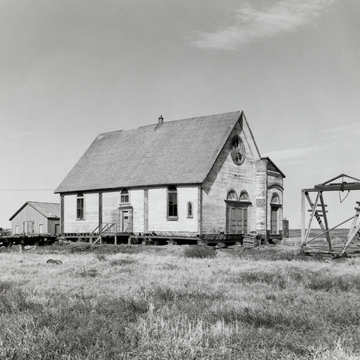The most notable building in the Hammon Consolidated power plant complex is Saint Joseph's Roman Catholic Church. Although serving the ignominious role of a gold-company warehouse and stripped of its steeple, Saint Joseph's remains the only church building from Nome's early history. Constructed in 1901, the 40-foot-by-60-foot church had an 88-foot steeple that supported a large, electrically lit cross serving as a beacon over the tundra and sea. This cross was deemed so important that the city paid the cost of illuminating it. Originally located at Steadman and King's Place, the building was moved to its present site in 1946 and oriented with its back to the street. The building's rear facade had a lower, gable-roofed sanctuary; this sanctuary was removed and warehouse-type doors were installed. On its original front, two round arches surmount the double-leaf doorway, and there is a rose window in the gable. The tower has been chopped off above the first story. The wood-framed building has novelty siding; corner pilasters and buttresses have been removed. When the Catholics built
You are here
Saint Joseph's Roman Catholic Church
1901
If SAH Archipedia has been useful to you, please consider supporting it.
SAH Archipedia tells the story of the United States through its buildings, landscapes, and cities. This freely available resource empowers the public with authoritative knowledge that deepens their understanding and appreciation of the built environment. But the Society of Architectural Historians, which created SAH Archipedia with University of Virginia Press, needs your support to maintain the high-caliber research, writing, photography, cartography, editing, design, and programming that make SAH Archipedia a trusted online resource available to all who value the history of place, heritage tourism, and learning.

